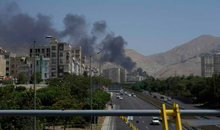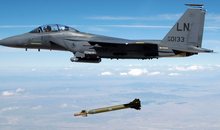
 Flash News
Flash News
SPAK conducts searches at Ergys Agas' businesses and residences, seizes two vehicles
Members of criminal organizations! 3 Albanians extradited from Dubai today
Berisha warns of new facts about the electoral farce: Don't forget that the laptop hasn't started talking yet
Berisha to gather political leaders tomorrow
Vote recount, KAS member: Less than 10% of ballot boxes have been counted, some candidates have undeserved ballots

Nadia Elbasani*
We all saw clearly how technology in the recent clashes between Israel and Iran served as a means to rapidly escalate the tensions of physical reality, serving as the main stage for the clash between nations.
On June 13, Israel followed the latest trend of cyberattacks intertwined with physical ones; it struck strategic Iranian facilities, such as the nuclear facilities in Natanz, through airstrikes. Operation “Rising Lion” combined precision missiles, highly autonomous drones, and cyber interventions. It should be noted that in the military and innovation scene, Israel is among the global leaders. This best shows that such preparation is now an integral part of a conflict.
On the other hand, Iran is not far behind in using technology as a tool of war, causing a 700% increase in DDoS attacks against Israeli systems on June 14. As a result of this offensive, coming from Iranian groups such as “Handal” and “Black Shadow”, critical Israeli systems such as the national electricity grid, water pumping stations, and traffic management systems in Tel Aviv also suffered temporary disruptions. An important element must be understood: a cyber attack is both a decrease in the reputation of a state and a disruption to daily life.
Then, on June 17, a cyberattack by the Predatory Sparrow group, linked to Israeli intelligence, first affected the financial system of Bank Sepah, which was responsible for financing IRGC projects. ATMs stopped working in some areas, mobile apps were blocked, and the public message after the attack was: “We have deleted your data – this is just the beginning.”
This month's list of events is not simply a war episode; it is a demonstration of a new dimension that conflicts between nations have taken on. Autonomous drones have become the new tool of modern warfare. As this month has demonstrated, the new means of warfare track and execute targets found by facial recognition, voice recognition, or even movement, marking a more intelligent, precise, and automated way of killing than traditional methods.
These events have made us realize that technology today only requires an “approval” button to replace a process that we can now, without fear, consider obsolete. These clashes proved that nations have technology as part of their military strategy.
The mix between international law and technological ethics, the boundaries between what is permissible and what is prohibited, have become so blurred that the question arises: Is international law prepared for the era of digital warfare?
Today, more than ever, it is noticeable that there is no international convention prohibiting cyber attacks on civilian infrastructure, or mechanisms for investigating and punishing cyber attacks with consequences for civilians. Terror and attacks on citizens, in the name of a conflict, today also come through a cyber attack, where anyone can be targeted. This is not simply a confrontation for military dominance, but a competition through technology and its means.
*The author is a lecturer in Cybersecurity Law
Latest news



Noka: Policemen were running from morning to night for SP votes
2025-06-19 21:31:03
The three zodiac signs that will be disappointed in love this month
2025-06-19 21:18:48
Accused of murder due to blood feud, 48-year-old arrested in England
2025-06-19 21:06:57
Vasili releases video: Tirana-Kashar segment full of gravel, no workers around!
2025-06-19 21:00:48

Tirana without a coach, four names considered for the white-and-blue bench
2025-06-19 20:21:12

Rinderpest/ A new outbreak appears in Shkodra, 200 sheep affected
2025-06-19 20:01:50

Scientists raise the alarm: Earth risks exceeding the 1.5°C warming limit!
2025-06-19 19:37:44

"Fiscal Peace" without consultation with the EU, Brussels concerned
2025-06-19 19:05:23
Trump signs executive order extending TikTok ban in US for another three months
2025-06-19 19:03:35

A special Task Force on immigration is established in cooperation with Italy
2025-06-19 18:23:58
Drug trafficking gang busted in Italy, 25 people arrested, including Albanians
2025-06-19 18:18:33
AMF denounces a suspicious cryptocurrency investment platform
2025-06-19 18:06:07


Technology as a tool of war between Israel and Iran
2025-06-19 17:27:54




EU divided over Israel's right to bomb Iran
2025-06-19 16:10:42

Analysis/ How is Russia spreading propaganda in the Albanian language?
2025-06-19 15:49:18
Session in the Criminal Court, MP Qani Xhafa is fined
2025-06-19 15:33:30
Members of criminal organizations! 3 Albanians extradited from Dubai today
2025-06-19 15:20:04

Lufta/ Zelenskyy bën thirrje për rritjen e presionit ndaj Rusisë
2025-06-19 14:56:02

Netanyahu warns Iran after attacks on Israeli hospital
2025-06-19 14:34:53

Attempted to enter Albania with false documents, 25-year-old arrested
2025-06-19 14:18:20
Psychology explains what happens in the brain of a person contemplating suicide
2025-06-19 14:01:25

These are the coldest zodiac signs
2025-06-19 13:45:18



Albanian man dies in hospital after accident in Italy
2025-06-19 13:02:45


Berisha to gather political leaders tomorrow
2025-06-19 12:32:23

Iran confirms meeting with representatives of Britain, Germany and France
2025-06-19 12:11:33


The constitution of the Kosovo Assembly fails for the 34th time
2025-06-19 11:30:28


Albania's nuclear bomb!
2025-06-19 10:52:02

Prej 4 ditësh e zhdukur, humb gjurmët adoleshentja shqiptare në Greqi
2025-06-19 10:33:11
Choosing a child's name, expert reveals three key factors
2025-06-19 10:29:17


Another request for release from house arrest
2025-06-19 09:49:14
Who is the 18-year-old who stole the crown of "Miss Albania 2025"?
2025-06-19 09:41:37

Arrestohet punonjësi i shërbimeve funerale, vidhte në varrezat e Korçës
2025-06-19 09:13:03
Foreign exchange, June 19, 2025
2025-06-19 09:00:33
Montenegrin arrested in Spain for involvement in a structured criminal group
2025-06-19 08:55:04
BBC: Trump has approved the plan to attack Iran
2025-06-19 08:45:01
Draft reports from Brussels expose 'government facade' towards integration
2025-06-19 08:31:21
Horoscope, what do the stars have in store for you today?
2025-06-19 08:17:33

Morning Post/ In 2 lines: What mattered yesterday in Albania
2025-06-19 07:49:56

Zhulali: EU does not tolerate basic standards, membership is a political process
2025-06-18 22:40:09
Recount process/Këlliçi: DP seeks 14th mandate in Tirana
2025-06-18 22:11:20
Hell in the Gjadri camp, 45 attempted injuries and violent protests
2025-06-18 21:49:49


Israel strikes National Police headquarters in Iran, several injured reported
2025-06-18 21:29:11




Why World War III is 'speaking', and the Albanian PM Rama is silent
2025-06-18 20:08:03
Avoid drying towels in the sun, here's how to keep them soft
2025-06-18 20:07:53

Cannabis legalization in Albania, new law, old risks
2025-06-18 19:39:54

Pope Leo XIV calls for peace: Advanced weapons are temptations we must reject
2025-06-18 19:22:29
Iran faces near-total internet blackout
2025-06-18 19:07:09




INSTAT: Heart diseases, the leading cause of death in Albania during 2024
2025-06-18 18:05:33



Trump does not rule out the possibility of striking Iran
2025-06-18 17:19:35
Accident on the Grand Ring Road, two cars collide
2025-06-18 17:05:57
